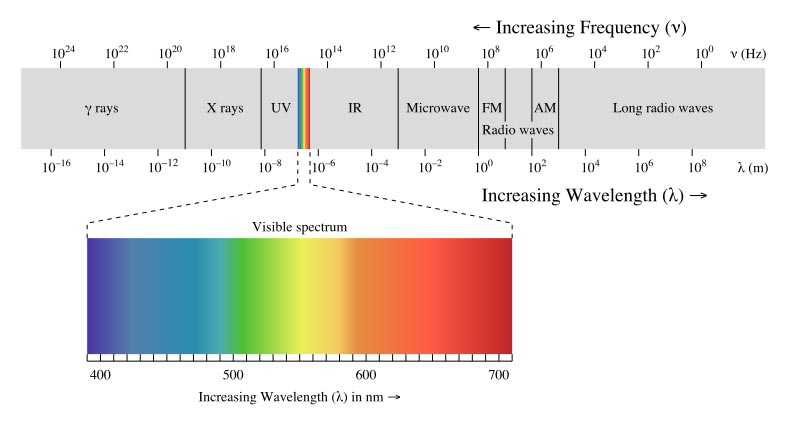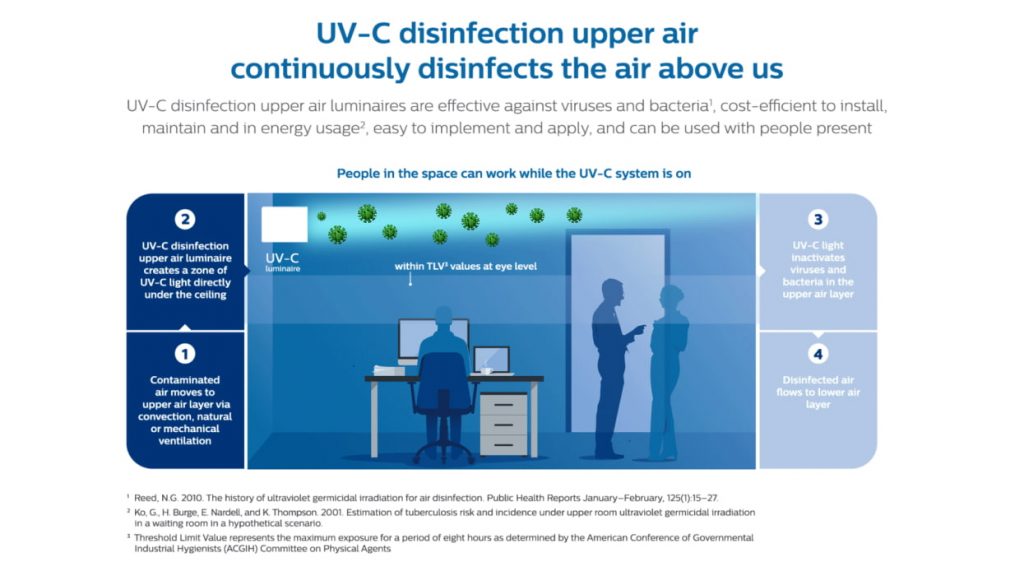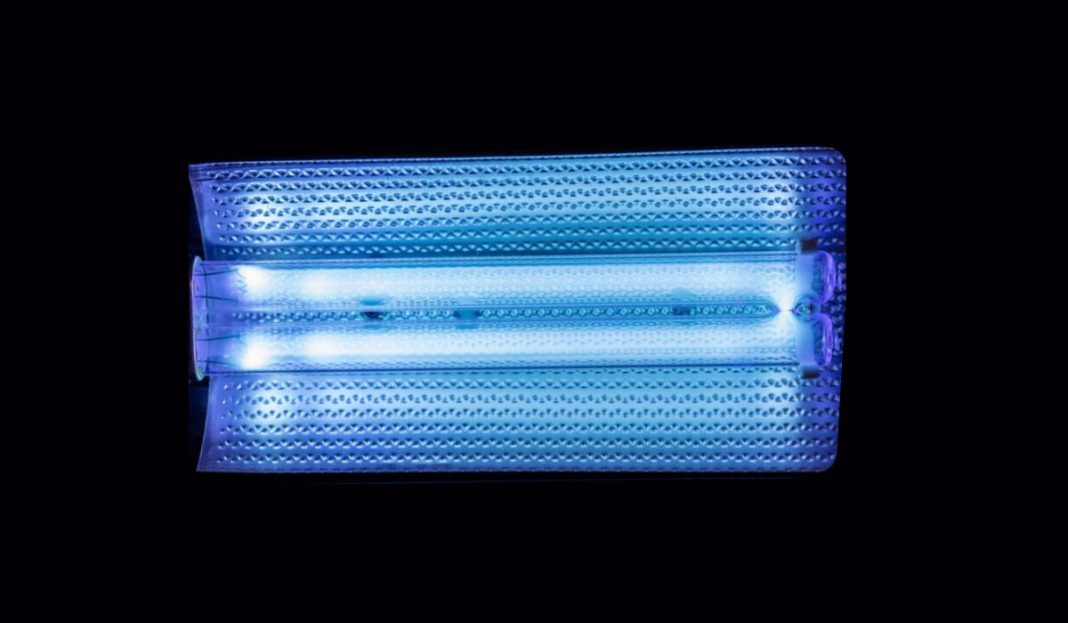Ultraviolet C
Short-wave UV, germicidal UV, ionizing radiation at shorter wavelengths, completely absorbed by the ozone layer and atmosphere: hard Ultraviolet light.
Ultraviolet light
Ultraviolet (UV) light is a component of the electromagnetic spectrum that falls in the region between visible light and X-Rays.

This invisible radiation includes the wavelength range of 100 nm to 400 nm. UV light can be further subdivided and categorized into four separate regions:
- 100 nm to 200 nm
Far UV or vacuum UV (these wavelengths only propagate in a vacuum) - 200 nm to 280 nm
UVC – useful for disinfection and sensing - 280 nm to 315 nm
UVB – useful for curing, and medical applications - 315 nm to 400 nm
UVA (or “near UV”) – useful for printing, curing, lithography, sensing and medical applications
UVC radiation is a known disinfectant for air, water, and nonporous surfaces. UVC radiation has effectively been used for decades to reduce the spread of bacteria, such as tuberculosis. For this reason, UVC lamps are often called “germicidal” lamps.
How Does UV-C Light Technology Work?
As we mentioned earlier, UV-C utilizes short-wavelength ultraviolet radiation — wavelengths of 200-300 nanometers. This short wavelength carries the amount of energy necessary to inactivate microorganisms. When UV-C light is applied, the following occurs:
- High energy from a UV-C wavelength is absorbed into the RNA and DNA of the cell.
- This energy absorption damages nucleic acid, disrupting the microorganism’s DNA.
- When DNA is disrupted, the microorganism is neutralized
- The microorganism cannot perform any vital cellular functions, which means it cannot reproduce.
For you, this means the microorganism cannot contribute to further disease spread or infection.
For example, this is how the upper air disinfection work

Is UV-C Light An Effective Method of Pathogen Control?
UV-C light treatment is an effective, chemical-free method of infection prevention. It’s shown to reduce the levels of bacteria and funguses in the air, and in some studies has been shown to reduce the number of overall infections in hospitals. UV-C light treatment has been used for decades to reduce the spread of bacteria.
While any environment — hospital, dental, educational, and beyond — must employ a range of disinfection and environmental treatment methods, UV-C light treatment is an especially effective technology for actively creating a cleaner environment in any setting, medical or commercial. Here are just a few of the benefits that UV-C technology can provide.
Is it safe to use a UV-C lamp for disinfection purposes at home?
Consider both the risks of UV-C lamps to people and objects and the risk of incomplete inactivation of virus.
Risks: UVC lamps used for disinfection purposes may pose potential health and safety risks depending on the UVC wavelength, dose, and duration of radiation exposure. The risk may increase if the unit is not installed properly or used by untrained individuals.
Direct exposure of skin and eyes to UV-C radiation from some UVC lamps may cause painful eye injury and burn-like skin reactions. Never look directly at a UVC lamp source, even briefly. If you have experienced an injury associated with using a UVC lamp, we encourage you to report it to the FDA.
Some UV-C lamps generate ozone. Ozone inhalation can be irritating to the airway.
UVC can degrade certain materials, such as plastic, polymers, and dyed textile.
Some UV-C lamps contain mercury. Because mercury is toxic even in small amounts, extreme caution is needed in cleaning a lamp that has broken and in disposing of the lamp.
Effectiveness: The effectiveness of UVC lamps in inactivating the SARS-CoV-2 virus is unknown because there is limited published data about the wavelength, dose, and duration of UVC radiation required to inactivate the SARS-CoV-2 virus. It is important to recognize that, generally, UV-C cannot inactivate a virus or bacterium if it is not directly exposed to UVC. In other words, the virus or bacterium will not be inactivated if it is covered by dust or soil, embedded in porous surface or on the underside of a surface.
To learn more about a specific UV-C lamp, you may want to:
- Ask the manufacturer about the product’s health and safety risks and about the availability of instructions for use/training information.
- Ask whether the product generates ozone.
- Ask what kind of material is compatible with UV-C disinfection.
- Ask whether the lamp contains mercury. This information may be helpful if the lamp is damaged and you need to know how to clean up and/or dispose of the lamp.
What are the different types of lamps that can produce UV-C radiation?
- Low-pressure mercury lamp: Historically, the most common type of lamp used to produce UVC radiation was the low-pressure mercury lamp, which has its main (>90%) emission at 254 nm. Other wavelengths are also produced by this type of lamp. There are other lamps available that emit a broad range of UV wavelengths, but also emit visible and infrared radiation.
- Excimer lamp or Far-UVC lamp: Type of lamp, called an “excimer lamp”, with a peak emission of around 222 nm.
- Pulsed xenon lamps: These lamps, which emit a short pulse of broad spectrum (including UV, visible and infrared) light have been filtered to emit mainly UVC radiation and are sometimes employed in hospital settings to treat environmental surfaces in operating rooms or other spaces. These are normally employed when no humans are occupying the space.
- Light-emitting diodes (LEDs): Light-emitting diodes (LEDs) that produce UV radiation are also becoming more commonly available. Typically, LEDs emit a very narrow wavelength band of radiation. Currently available UV LEDs have peak wavelengths at 265 nm, 273 nm, and 280 nm, among others. One advantage of LEDs over low-pressure mercury lamps is that they contain no mercury. However, the small surface area and higher directionality of LEDs may make them less effective for germicidal applications.
sources: FDA; lighting.philips; UVangel; KLARAN UNIVERSITY



OF NATURAL PRODUCTS AND EXTRACTS


